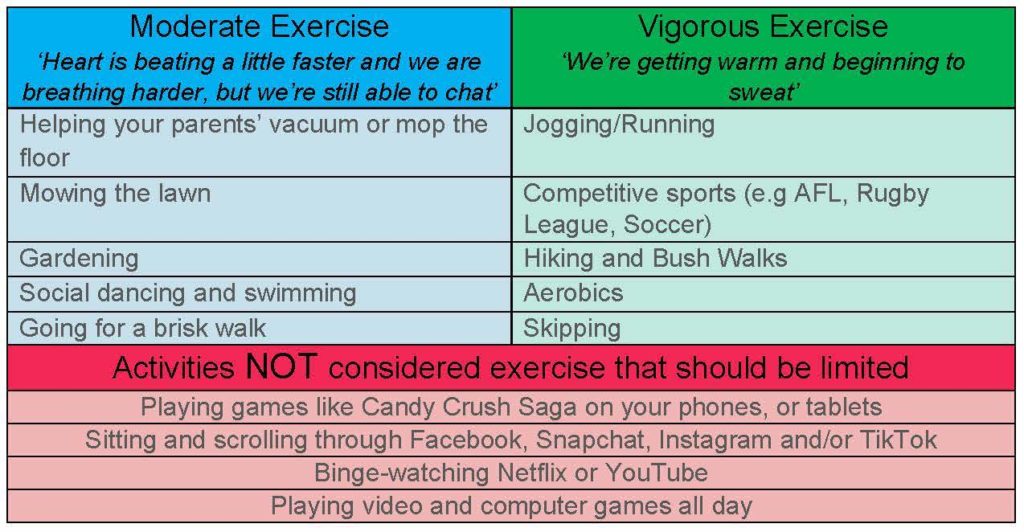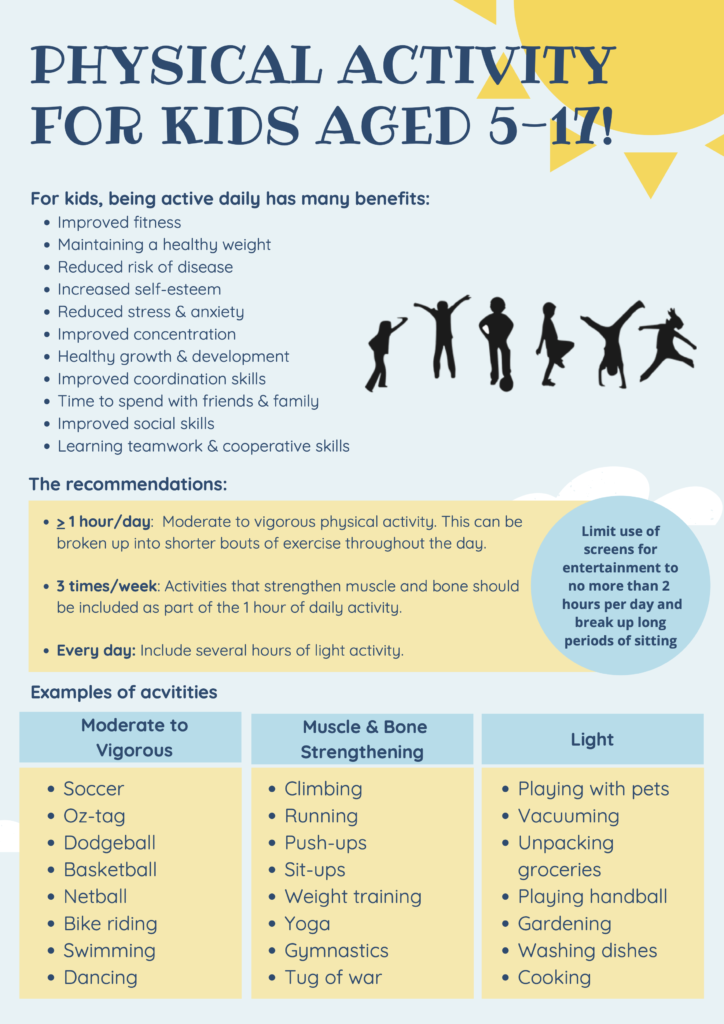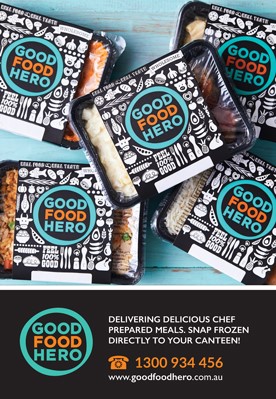Sports and Physical Activity
What is ‘moderate to vigorous exercise’?

Nutrition in Sport
Eating before and after exercise
If you’re playing sport or doing exercise it’s important to eat beforehand to make sure your body has enough energy to perform at your best. Whether you are doing light exercise such as a walk, or working really hard and doing an intense activity, make sure you have eaten within the past 3 or 4 hours.
Okay, but what should I eat?
It is best to have foods that contain carbohydrates before exercise as this is the main fuel source for your muscles and can help you remain focused and alert. Some great ideas for pre–exercise snacks include those listed below, as well as wholegrain cereals, sandwiches, sushi rolls and spaghetti.
After we finish exercise, our body is tired and has used up energy. Therefore, we need to refuel our bodies with more energy so that we can recover and replace what has been used. In meals and snacking options after exercise try to include protein as well as carbohydrates, as these can assist in optimising growth and recovery. As well as those listed below, some awesome post-exercise snacks and meals include meat and salad rolls/wraps, yoghurt and fruit, homemade steak burgers and stir-fry.
Hydration (please see ‘Sports Hydration’ for more information)
Water is essential for our bodies and is the preferred fluid when we exercise. It keeps us cool, helps with digestion and gets rid of waste for us.
Water is lost through sweat, breathing and urination, and if it is not replaced, we can become dehydrated.

During exercise we sweat more than usual, so we need to drink even more water to replace what is lost. In order to prevent dehydration and remain hydrated, make sure you drink water before, during (every 15-30minutes) and after your sports or physical activity.
Where do sports drinks fit in?
Sports drinks, such as Powerade and Gatorade, are made up of water with added sugars and electrolytes (fancy word for salts and minerals). These drinks can help us re–hydrate, however, the high sugar content and minimal benefit of sports drinks for children and teenagers make water the preferred choice for physical activity. In cases where sports last longer than 90 minutes, and/or are played in hot, humid conditions, sports drinks combined with plain water can assist in re-energising us. However, drinking water and having a small snack such as a piece of fruit, cheese and crackers, or yogurt can be as beneficial as a sports drink without the associated high sugar content that can damage our teeth, and potentially lead to excessive energy intake and weight gain.
Protein powders
Protein is essential for the growth and development of muscle, as well as helping our body recover after exercise. The amount of protein we require to build muscle however, can be obtained through a well-balanced, varied diet containing poultry, grains, dairy, fruit and vegetables (See ‘Australian Dietary Guidelines’). Protein powders are a supplement often used by athletes, such as bodybuilders, to try and build muscles stronger and faster than normal. The protein usually comes from milk and has been made into a concentrated powder which is usually added to water or milk and consumed right before or after exercise. Protein powders and drinks are often high in kilojoules (energy), and unnecessary for children and teenagers. In fact, overconsumption of protein can contribute to excessive energy intake leading to weight gain, and damage to our bones and kidneys.
So, what are some things I can do to make sure I am getting enough protein?
All in all, growing children and teenagers do NOT need to use protein powders, as a healthy balanced diet that includes protein-rich foods and snacks throughout the day is enough to keep our muscles and body strong and healthy.
Foods that are high in protein:
- Lean meat and poultry
- Fish and seafood
- Eggs
- Dairy (milk, yoghurt, and cheese)
- Nuts
Meal and snacking ideas rich in protein:
- Milk in cereal
- Eggs on toast
- Cheese on crackers
- Tuna on sandwiches
- Nuts with afternoon tea
- Meat with three veg at dinner
What about vegetarians and vegans? (Please see ‘Vegan and vegetarian diets’ for more information)
Vegetarians and vegans can find it more difficult to find foods and drinks that are high in protein, however, there are increasingly more protein options becoming available, including:
- Legumes (e.g chickpeas, lentils, beans)
- Greek Yoghurt (*For vegans – calcium-fortified yoghurt e.g soy and coconut)
- Cheese
- Dairy Milk (*For vegans – non-dairy alternatives such as soy or almond milk)
- Tofu
- Nuts (e.g almonds, walnuts, cashews, peanuts)
IMPORTANT NOTE: Consultation with an Accredited Practicing Dietitian (APD) should be undertaken if children/teenagers are contemplating or currently following a vegan or vegetarian diet.
Body Image
It is important that exercise and nutrition for children and teenagers is focused on positive long-term health. Strict ‘dieting’ should not be undertaken by children or teenagers regardless of whether they participate in sport or not, as this can contribute to negative health and mental consequences. Furthermore, pressure should NEVER be put on children or teenagers to replicate or strive for a particular body shape, weight, or appearance. Instead, parents, teachers and coaches should focus on promoting exercise and healthy eating as part of a well-balanced lifestyle with the health and wellbeing of teenagers always the priority.
Physical Activity for Kids Flyer
Download our Physical Activity for Kids flyer which outlines the physical activity and exercise guidelines for 5-17 year olds, the importance of physical activity and some practical examples.







